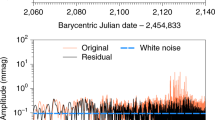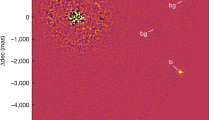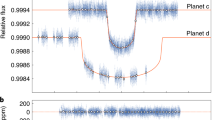Abstract
51 Pegasi, one of many nearby Sun-like stars, was undistinguished until the recent detections of apparent variations in its radial velocity, which have been attributed to reflex motion caused by a planetary companion1,2. The velocity variation inferred from variations in the spectral lines of 51 Peg has an amplitude of 56–59 m s−l and a period of 4.23 days, implying a planet of at least half the mass of Jupiter moving in an embarrassingly small orbit of 0.05 astronomical units. But the techniques currently used to identify these exceedingly small radial velocity variations do not allow for the possibility that changes of comparable size might be occurring in the intrinsic shapes of the spectral lines; such variations are expected when a star pulsates or has spots on its surface, and could be mistaken for radial velocity variations. Here I present high-spectral-resolution observations of 51 Peg that show that its spectral lines exhibit intrinsic shape variations with a period of 4.23 days, and an amplitude comparable to that previously attributed1,2 to radial velocity variations. As the presence of a planet will not influence the shapes of spectral lines, these variations are likely to reflect a hitherto unknown mode of stellar oscillation. The presence of a planet is not required to explain the data.
This is a preview of subscription content, access via your institution
Access options
Subscribe to this journal
Receive 51 print issues and online access
$199.00 per year
only $3.90 per issue
Buy this article
- Purchase on Springer Link
- Instant access to full article PDF
Prices may be subject to local taxes which are calculated during checkout
Similar content being viewed by others
References
Mayor, M. & Queloz, D. A Jupiter-mass companion to a solar-type star. Nature 378, 355–359 (1995).
Marcy, G. W. et al. The planet around 51 Pegasi. Astrophys. J. (submitted).
Gray, D. F., Baliunas, S. L., Lockwood, G. W. & Skiff, B. A. Variations of β Comae through a magnetic minimum. Astrophys. J. 456, 365–369 (1996).
Gray, D. F., Baliunas, S. L., Lockwood, G. W. & Skiff, B. A. Magnetic, photometric, temperature, and granulation variations of ξ Boo A 1984–1993. Astrophys. J. 465, 945–950 (1996).
Gray, D. F. in Instrumentation and Research Programmes for Small Telescopes (eds Hearnshaw, J. B. & Cottrell, P. L.) 401–412 (Reidel, Dordrecht, 1986).
Dravins, D., Lindegren, L. & Nordlund, A. Solar granulation—influence of convection on spectral line asymmetries and wavelength shifts. Astron. Astrophys. 96, 345–364 (1981).
Brandt, P. N. & Solanki, S. K. Solar line asymmetries and the magnetic filling factor. Astron. Astrophys. 231, 221–234 (1990).
Gray, D. F. Lectures on Spectral-Line Analysis: F, G, and K Stars Ch. 4 (Arva, Ontario, 1988).
Gray, D. F. Observations of spectral line asymmetries and convective velocities in F, G, and K stars. Astrophys. J. 255, 200–209 (1982).
Hatzes, A. P. Simulations of stellar radial-velocity and spectral line bisector variations. I. Nonradial pulsations. Publ. Astron. Soc. Pacif. 108, 839–843 (1996).
Toner, C. G. & Gray, D. F. The starpatch on the G8 dwarf ξ Boo A. Astrophys. J. 334, 1008–1020 (1988).
Gray, D. F. Spectral line-depth ratios as temperature indicators for cool stars. Publ. Astron. Soc. Pacif. 106, 1248–1257 (1994).
Gray, D. F. Comparing the Sun with other stars along the temperature coordinate. Publ. Astron. Soc. Pacif. 107, 120–123 (1995).
Gray, D. F. & Livingston, W. C. Monitoring the solar temperature: empirical calibration of the temperature sensitivity of CIλ5380. Astrophys. J. 474, 798–801 (1997).
Perryman, M. A. C. et al. Happarcos distances and mass limits for the planetary candidates: 47 UMa, 70 Vir, and 51 Peg. Astron. Astrophys. 310, L21–L24 (1996).
Henry, G. W., Baliunas, S. L., Donahue, R. A., Soon, W. H. & Saar, S. H. Properties of Sun-like stars with planets. Astrophys. J. 474, 503–510 (1997).
Dravins, D. Solar and Stellar Granulation (eds Rutten, R. J. & Severino, G.) 153–160 (Kluwer, Dordrecht, 1989).
Hatzes, A. P., Cochran, W. D. & Johns-Krull, M. Testing the planet hypothesis: a search for variability in the spectral lines shapes of 51 Pegasi. Astrophys. J. (submitted).
Unno, W., Osaki, Y., Ando, H. & Shibahashi, H. Nonradial Oscillations of Stars (Univ. Tokyo Press, 1979).
Xu, Z. The near-IR Na I doublet and Ca II triplet in late-type stars and the determination of stellar atmosphere parameters. Astron. Astrophys. 248, 367–388 (1991).
Edvardsson, B. et al. The chemical evolution of the galactic disk II. Observational data. Astron. Astrophys. 275, 101–152 (1993).
Walker, G. A. H., Yang, S., Irwin, A. W. & Campbell, B. Yellow giants: a new class of radial-velocity variable. Astrophys. J. 343, L21–L24 (1989).
Latham, D. W., Stefanik, R. P., Mazeh, T., Mayor, M. & Burki, G. The unseen companion of HD 114762—a probable brown dwarf. Nature 339, 38–40 (1989).
Marcy, G. W. & Butler, R. P. A planet orbiting 47 Ursae Majoris. Astrophys. J. 464, L153–L156 (1996).
Butler, R. P. & Marcy, G. W. A planetary companion to 70 Virginis. Astrophys. J. 464, L147–L151 (1996).
Butler, R. P., Marcy, G. W., Williams, E., Hauser, H. & Shirts, P. Three new ‘51 Peg-type’ planets. Astrophys. J. (submitted).
Cochran, W. D., Hatzes, A. P., Butler, R. P. & Marcy, G. W. The discovery of a planetary companion to 16 Cygni B. Astrophys. J. (submitted).
Author information
Authors and Affiliations
Rights and permissions
About this article
Cite this article
Gray, D. Absence of a planetary signature in the spectra of the star 51 Pegasi. Nature 385, 795–796 (1997). https://doi.org/10.1038/385795a0
Received:
Accepted:
Issue Date:
DOI: https://doi.org/10.1038/385795a0
This article is cited by
-
Five thousand exoplanets at the NASA Exoplanet Archive
Nature Astronomy (2022)
-
First exoplanet found around a Sun-like star
Nature (2019)
Comments
By submitting a comment you agree to abide by our Terms and Community Guidelines. If you find something abusive or that does not comply with our terms or guidelines please flag it as inappropriate.



